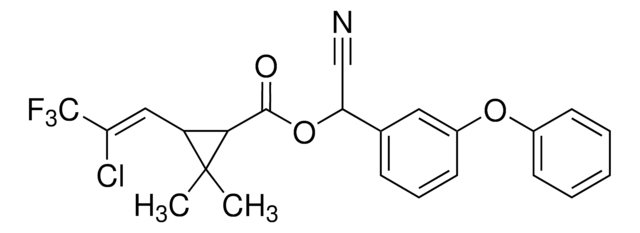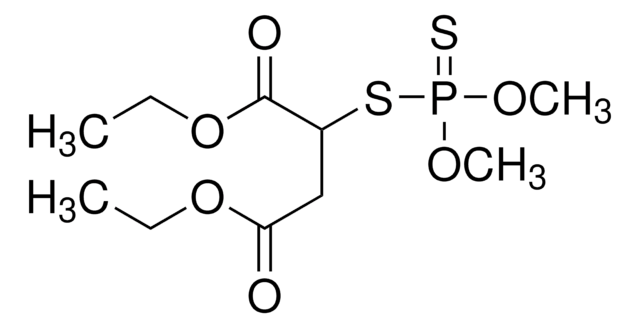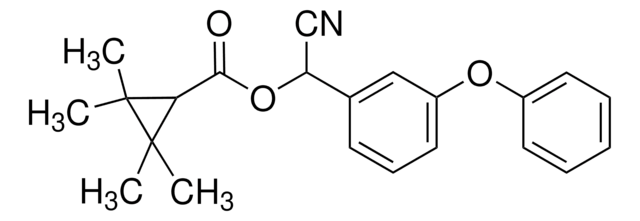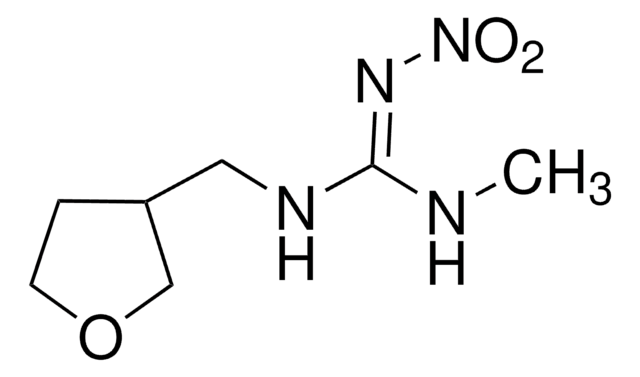Kluczowe dokumenty
33496
Flucythrinate
PESTANAL®, analytical standard, mixture of stereo isomers
Synonim(y):
α-Cyano-3-phenoxybenzyl 4-difluoromethoxy-α-isopropylphenylacetate
About This Item
Polecane produkty
klasa czystości
analytical standard
Poziom jakości
linia produktu
PESTANAL®
okres trwałości
limited shelf life, expiry date on the label
metody
HPLC: suitable
gas chromatography (GC): suitable
Zastosowanie
agriculture
environmental
Format
neat
temp. przechowywania
2-8°C
ciąg SMILES
CC(C)C(C(=O)OC(C#N)c1cccc(Oc2ccccc2)c1)c3ccc(OC(F)F)cc3
InChI
1S/C26H23F2NO4/c1-17(2)24(18-11-13-21(14-12-18)32-26(27)28)25(30)33-23(16-29)19-7-6-10-22(15-19)31-20-8-4-3-5-9-20/h3-15,17,23-24,26H,1-2H3
Klucz InChI
GBIHOLCMZGAKNG-UHFFFAOYSA-N
Szukasz podobnych produktów? Odwiedź Przewodnik dotyczący porównywania produktów
Opis ogólny
Zastosowanie
Informacje prawne
Hasło ostrzegawcze
Danger
Zwroty wskazujące rodzaj zagrożenia
Zwroty wskazujące środki ostrożności
Klasyfikacja zagrożeń
Acute Tox. 3 Oral - Acute Tox. 4 Inhalation - Aquatic Acute 1 - Aquatic Chronic 1 - Flam. Liq. 3
Kod klasy składowania
3 - Flammable liquids
Klasa zagrożenia wodnego (WGK)
WGK 3
Temperatura zapłonu (°F)
113.0 °F
Temperatura zapłonu (°C)
45 °C
Środki ochrony indywidualnej
Eyeshields, Faceshields, Gloves, type ABEK (EN14387) respirator filter
Wybierz jedną z najnowszych wersji:
Certyfikaty analizy (CoA)
Nie widzisz odpowiedniej wersji?
Jeśli potrzebujesz konkretnej wersji, możesz wyszukać konkretny certyfikat według numeru partii lub serii.
Masz już ten produkt?
Dokumenty związane z niedawno zakupionymi produktami zostały zamieszczone w Bibliotece dokumentów.
Nasz zespół naukowców ma doświadczenie we wszystkich obszarach badań, w tym w naukach przyrodniczych, materiałoznawstwie, syntezie chemicznej, chromatografii, analityce i wielu innych dziedzinach.
Skontaktuj się z zespołem ds. pomocy technicznej









